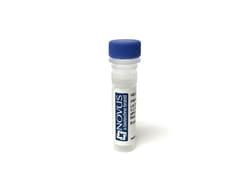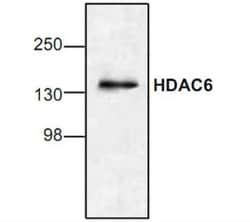7199551
Kv12.1 Antibody, Novus Biologicals™
Rabbit Polyclonal Antibody
Manufacturer: Fischer Scientific
The price for this product is unavailable. Please request a quote
Antigen
Kv12.1
Applications
Immunohistochemistry (Paraffin), Western Blot, Immunohistochemistry
Conjugate
Unconjugated
Host Species
Rabbit
Target Species
Human
Gene Alias
ELK, ELK channel 3, ELK1, ELK3, ether-a-go-go-like potassium channel 1, Ether-a-go-go-like potassium channel 3, hElk1, Kv12.1, potassium voltage-gated channel subfamily H member 8, potassium voltage-gated channel, subfamily H (eag-related), member 8, Voltage-gated potassium channel subunit Kv12.1
Gene Symbols
KCNH8
Primary or Secondary
Primary
Content And Storage
Store at 4C short term. Aliquot and store at -20C long term. Avoid freeze-thaw cycles.
Concentration
LYOPH
Classification
Polyclonal
Form
Antisera
Regulatory Status
RUO
Gene Accession No.
Q96L42
Gene ID (Entrez)
131096
Isotype
IgG
Purification Method
Unpurified
Test Specificity
KCNH8.
Description
- Description Kv12.1 Polyclonal specifically detects Kv12.1 in Human samples
- It is validated for Western Blot, Immunohistochemistry, Immunohistochemistry-Paraffin.
Compare Similar Items
Show Difference
Antigen: Kv12.1
Applications: Immunohistochemistry (Paraffin), Western Blot, Immunohistochemistry
Conjugate: Unconjugated
Host Species: Rabbit
Target Species: Human
Gene Alias: ELK, ELK channel 3, ELK1, ELK3, ether-a-go-go-like potassium channel 1, Ether-a-go-go-like potassium channel 3, hElk1, Kv12.1, potassium voltage-gated channel subfamily H member 8, potassium voltage-gated channel, subfamily H (eag-related), member 8, Voltage-gated potassium channel subunit Kv12.1
Gene Symbols: KCNH8
Primary or Secondary: Primary
Content And Storage: Store at 4C short term. Aliquot and store at -20C long term. Avoid freeze-thaw cycles.
Concentration: LYOPH
Classification: Polyclonal
Form: Antisera
Regulatory Status: RUO
Gene Accession No.: Q96L42
Gene ID (Entrez): 131096
Isotype: IgG
Purification Method: Unpurified
Test Specificity: KCNH8.
Antigen:
Kv12.1
Applications:
Immunohistochemistry (Paraffin), Western Blot, Immunohistochemistry
Conjugate:
Unconjugated
Host Species:
Rabbit
Target Species:
Human
Gene Alias:
ELK, ELK channel 3, ELK1, ELK3, ether-a-go-go-like potassium channel 1, Ether-a-go-go-like potassium channel 3, hElk1, Kv12.1, potassium voltage-gated channel subfamily H member 8, potassium voltage-gated channel, subfamily H (eag-related), member 8, Voltage-gated potassium channel subunit Kv12.1
Gene Symbols:
KCNH8
Primary or Secondary:
Primary
Content And Storage:
Store at 4C short term. Aliquot and store at -20C long term. Avoid freeze-thaw cycles.
Concentration:
LYOPH
Classification:
Polyclonal
Form:
Antisera
Regulatory Status:
RUO
Gene Accession No.:
Q96L42
Gene ID (Entrez):
131096
Isotype:
IgG
Purification Method:
Unpurified
Test Specificity:
KCNH8.
Antigen: HDAC6
Applications: Immunohistochemistry, Western Blot
Conjugate: Unconjugated
Host Species: Rabbit
Target Species: Human, Rat, Mouse
Gene Alias: EC 3.5.1.98, HD6FLJ16239, histone deacetylase 6, JM21, KIAA0901
Gene Symbols: HDAC6
Primary or Secondary: Primary
Content And Storage: Aliquot and store at -20C or -80C. Avoid freeze-thaw cycles.
Concentration: __
Classification: Polyclonal
Form: __
Regulatory Status: RUO
Gene Accession No.: Q9Z2V5
Gene ID (Entrez): 10013
Isotype: IgG
Purification Method: Affinity Purified
Test Specificity: The antibody does not cross-react with other HDAC proteins including HDAC1, 2, 3, 4, 5, 7, and 8.
Antigen:
HDAC6
Applications:
Immunohistochemistry, Western Blot
Conjugate:
Unconjugated
Host Species:
Rabbit
Target Species:
Human, Rat, Mouse
Gene Alias:
EC 3.5.1.98, HD6FLJ16239, histone deacetylase 6, JM21, KIAA0901
Gene Symbols:
HDAC6
Primary or Secondary:
Primary
Content And Storage:
Aliquot and store at -20C or -80C. Avoid freeze-thaw cycles.
Concentration:
__
Classification:
Polyclonal
Form:
__
Regulatory Status:
RUO
Gene Accession No.:
Q9Z2V5
Gene ID (Entrez):
10013
Isotype:
IgG
Purification Method:
Affinity Purified
Test Specificity:
The antibody does not cross-react with other HDAC proteins including HDAC1, 2, 3, 4, 5, 7, and 8.
Antigen: DPPIV/CD26
Applications: Flow Cytometry, ELISA
Conjugate: Unconjugated
Host Species: Rat
Target Species: Mouse
Gene Alias: ADABP, ADCP-2, ADCP2DPP IV, Adenosine deaminase complexing protein 2TP103, CD26 antigen, CD26T-cell activation antigen CD26, dipeptidyl peptidase 4, Dipeptidyl peptidase IV, dipeptidylpeptidase 4, dipeptidyl-peptidase 4, dipeptidylpeptidase IV (CD26, adenosine deaminase complexing protein 2), DPPIV, EC 3.4.14.5
Gene Symbols: DPP4
Primary or Secondary: Primary
Content And Storage: Store at 4C short term. Aliquot and store at -20C long term. Avoid freeze-thaw cycles.
Concentration: 1 mg/mL
Classification: Monoclonal
Form: Purified
Regulatory Status: RUO
Gene Accession No.: __
Gene ID (Entrez): 1803
Isotype: IgG2a
Purification Method: Protein G purified
Test Specificity: NB100-62997 recognises mouse CD26, which is also known as thymocyte-activating molecule (THAM). Murine CD26 is a type II integral membrane dipeptidyl-peptidase that is expressed at the cell surface as a heterodimer, of approximately 220 kDa, and has a soluble form in the plasma. The CD26 molecule is a multifunctional glycoprotein that has ectopeptidase activity and is also reported to be involved in cell adhesion, signal transduction in T lymphocytes and HIV infection. CD26 is differentially expressed on developing thymocytes and is upregulated on activated T-cells but is not expressed on resting and thioglycollate stimulated macrophages. Expression of CD26 has also been reported on cells from a variety of non-haematopoietic tissues including liver, intestine and kidney.
Antigen:
DPPIV/CD26
Applications:
Flow Cytometry, ELISA
Conjugate:
Unconjugated
Host Species:
Rat
Target Species:
Mouse
Gene Alias:
ADABP, ADCP-2, ADCP2DPP IV, Adenosine deaminase complexing protein 2TP103, CD26 antigen, CD26T-cell activation antigen CD26, dipeptidyl peptidase 4, Dipeptidyl peptidase IV, dipeptidylpeptidase 4, dipeptidyl-peptidase 4, dipeptidylpeptidase IV (CD26, adenosine deaminase complexing protein 2), DPPIV, EC 3.4.14.5
Gene Symbols:
DPP4
Primary or Secondary:
Primary
Content And Storage:
Store at 4C short term. Aliquot and store at -20C long term. Avoid freeze-thaw cycles.
Concentration:
1 mg/mL
Classification:
Monoclonal
Form:
Purified
Regulatory Status:
RUO
Gene Accession No.:
__
Gene ID (Entrez):
1803
Isotype:
IgG2a
Purification Method:
Protein G purified
Test Specificity:
NB100-62997 recognises mouse CD26, which is also known as thymocyte-activating molecule (THAM). Murine CD26 is a type II integral membrane dipeptidyl-peptidase that is expressed at the cell surface as a heterodimer, of approximately 220 kDa, and has a soluble form in the plasma. The CD26 molecule is a multifunctional glycoprotein that has ectopeptidase activity and is also reported to be involved in cell adhesion, signal transduction in T lymphocytes and HIV infection. CD26 is differentially expressed on developing thymocytes and is upregulated on activated T-cells but is not expressed on resting and thioglycollate stimulated macrophages. Expression of CD26 has also been reported on cells from a variety of non-haematopoietic tissues including liver, intestine and kidney.
Antigen: DPPIV/CD26
Applications: Flow Cytometry, ELISA
Conjugate: Unconjugated
Host Species: Rat
Target Species: Mouse
Gene Alias: ADABP, ADCP-2, ADCP2DPP IV, Adenosine deaminase complexing protein 2TP103, CD26 antigen, CD26T-cell activation antigen CD26, dipeptidyl peptidase 4, Dipeptidyl peptidase IV, dipeptidylpeptidase 4, dipeptidyl-peptidase 4, dipeptidylpeptidase IV (CD26, adenosine deaminase complexing protein 2), DPPIV, EC 3.4.14.5
Gene Symbols: DPP4
Primary or Secondary: Primary
Content And Storage: Store at 4C short term. Aliquot and store at -20C long term. Avoid freeze-thaw cycles.
Concentration: 1 mg/mL
Classification: Monoclonal
Form: Purified
Regulatory Status: RUO
Gene Accession No.: __
Gene ID (Entrez): 1803
Isotype: IgG2a
Purification Method: Protein G purified
Test Specificity: NB100-62997 recognises mouse CD26, which is also known as thymocyte-activating molecule (THAM). Murine CD26 is a type II integral membrane dipeptidyl-peptidase that is expressed at the cell surface as a heterodimer, of approximately 220 kDa, and has a soluble form in the plasma. The CD26 molecule is a multifunctional glycoprotein that has ectopeptidase activity and is also reported to be involved in cell adhesion, signal transduction in T lymphocytes and HIV infection. CD26 is differentially expressed on developing thymocytes and is upregulated on activated T-cells but is not expressed on resting and thioglycollate stimulated macrophages. Expression of CD26 has also been reported on cells from a variety of non-haematopoietic tissues including liver, intestine and kidney.
Antigen:
DPPIV/CD26
Applications:
Flow Cytometry, ELISA
Conjugate:
Unconjugated
Host Species:
Rat
Target Species:
Mouse
Gene Alias:
ADABP, ADCP-2, ADCP2DPP IV, Adenosine deaminase complexing protein 2TP103, CD26 antigen, CD26T-cell activation antigen CD26, dipeptidyl peptidase 4, Dipeptidyl peptidase IV, dipeptidylpeptidase 4, dipeptidyl-peptidase 4, dipeptidylpeptidase IV (CD26, adenosine deaminase complexing protein 2), DPPIV, EC 3.4.14.5
Gene Symbols:
DPP4
Primary or Secondary:
Primary
Content And Storage:
Store at 4C short term. Aliquot and store at -20C long term. Avoid freeze-thaw cycles.
Concentration:
1 mg/mL
Classification:
Monoclonal
Form:
Purified
Regulatory Status:
RUO
Gene Accession No.:
__
Gene ID (Entrez):
1803
Isotype:
IgG2a
Purification Method:
Protein G purified
Test Specificity:
NB100-62997 recognises mouse CD26, which is also known as thymocyte-activating molecule (THAM). Murine CD26 is a type II integral membrane dipeptidyl-peptidase that is expressed at the cell surface as a heterodimer, of approximately 220 kDa, and has a soluble form in the plasma. The CD26 molecule is a multifunctional glycoprotein that has ectopeptidase activity and is also reported to be involved in cell adhesion, signal transduction in T lymphocytes and HIV infection. CD26 is differentially expressed on developing thymocytes and is upregulated on activated T-cells but is not expressed on resting and thioglycollate stimulated macrophages. Expression of CD26 has also been reported on cells from a variety of non-haematopoietic tissues including liver, intestine and kidney.


